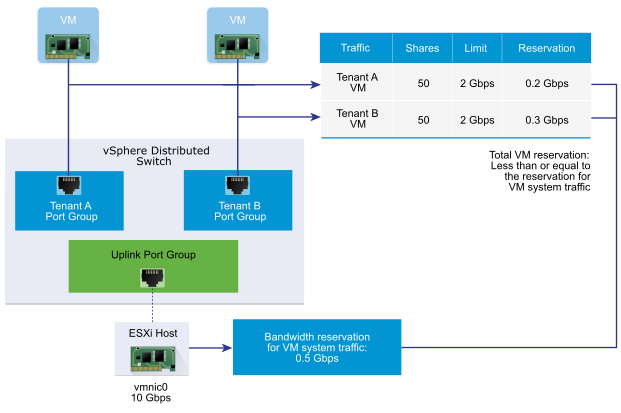Network I/O Control allocates bandwidth for virtual machines by using two models: allocation across the entire vSphere Distributed Switch based on network resource pools and allocation on the physical adapter that carries the traffic of a virtual machine.
Network Resource Pools
A network resource pool represents a part of the aggregated bandwidth that is reserved for the virtual machine system traffic on all physical adapters connected to the distributed switch.
For example, if the virtual machine system traffic has 0.5 Gbps reserved on each 10 GbE uplink on a distributed switch that has 10 uplinks, then the total aggregated bandwidth available for VM reservation on this switch is 5 Gbps. Each network resource pool can reserve a quota of this 5 Gbps capacity.
The bandwidth quota that is dedicated to a network resource pool is shared among the distributed port groups associated with the pool. A virtual machine receives bandwidth from the pool through the distributed port group the VM is connected to.
By default, distributed port groups on the switch are assigned to a network resource pool, called default, whose quota is not configured.

Defining Bandwidth Requirements for a Virtual Machine
You allocate bandwidth to an individual virtual machine similarly to allocating CPU and memory resources. Network I/O Control version 3 provisions bandwidth to a virtual machine according to shares, reservation, and limits that are defined for a network adapter in the VM hardware settings. The reservation represents a guarantee that the traffic from the virtual machine can consume at least the specified bandwidth. If a physical adapter has more capacity, the virtual machine may use additional bandwidth according to the specified shares and limit.
Bandwidth Provisioning to a Virtual Machine on the Host
To guarantee bandwidth, Network I/O Control implements a traffic placement engine that becomes active if a virtual machine has bandwidth reservation configured. The distributed switch attempts to place the traffic from a VM network adapter to the physical adapter that can supply the required bandwidth and is in the scope of the active teaming policy.
The total bandwidth reservation of the virtual machines on a host cannot exceed the reserved bandwidth that is configured for the virtual machine system traffic.
The actual limit and reservation also depends on the traffic shaping policy for the distributed port group the adapter is connected to. For example, if a VM network adapter requires a limit of 200 Mbps and the average bandwidth configured in the traffic shaping policy is 100 Mbps, then the effective limit becomes 100Mbps.
